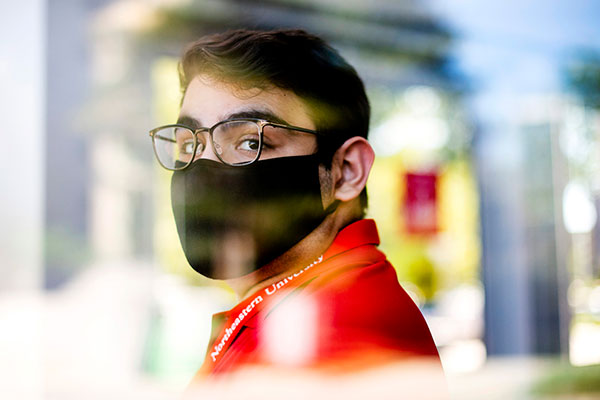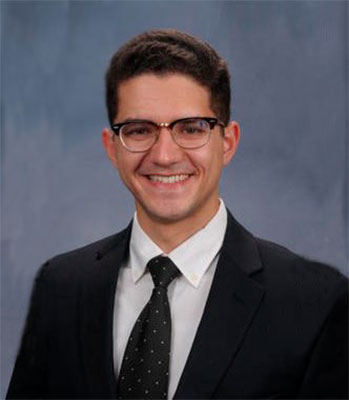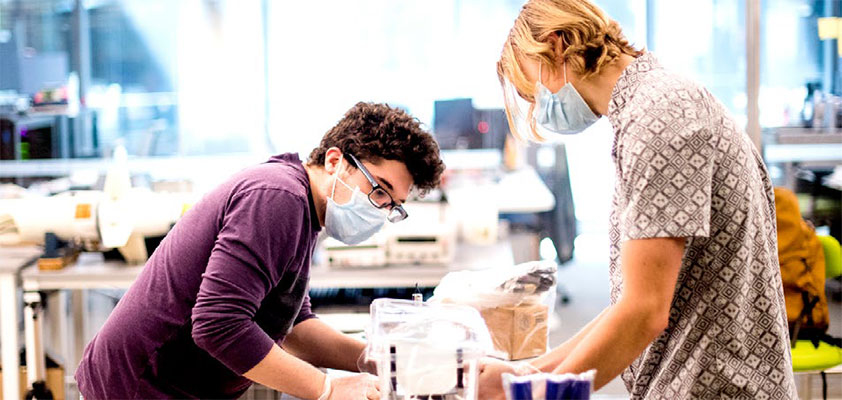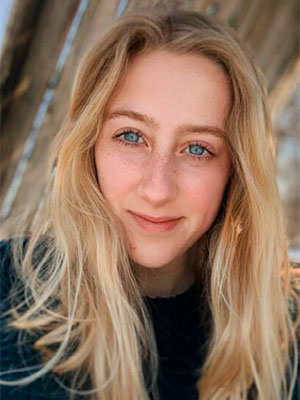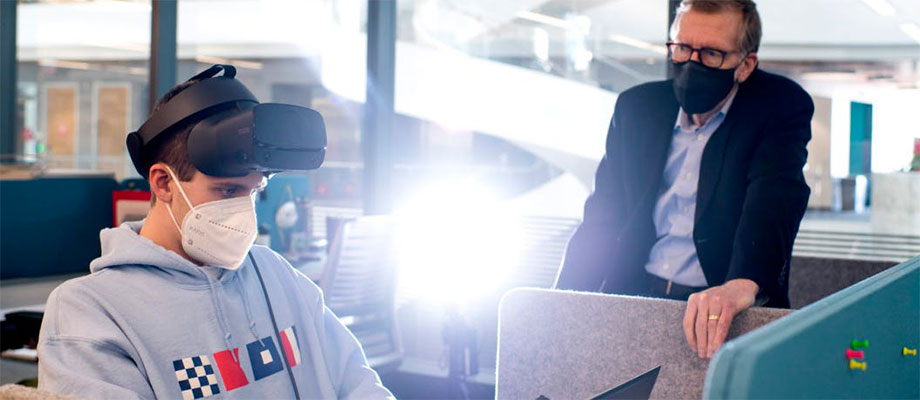COVID-19: Students Making a Difference

Over the past year-plus College of Engineering students have come to the cause, transitioning research, co-op experiences, and community efforts to address challenges caused by the pandemic. Here are just a few highlights of their contributions.
This article originally appeared in Engineering @ Northeastern magazine, Spring 2021.
One week after the pandemic forced him to leave the Boston campus in March 2020, Max Seidel, E’23, mechanical engineering, joined with a friend to launch Atlanta Face Shields from his hometown. The group has donated over 5,000 shields to hospitals, police departments, schools, and other organizations mainly in Georgia, though some were shipped as far away as Mexico City and Pittsburgh. Upon returning to campus in fall 2020, Seidel continued the face shield effort with his two 3D printers in his single dorm room. Atlanta Face Shields has also expanded to the University of Alabama, Georgia Tech, University of Maryland, and California State University San Marcos. The charity was inspired by a call to action by Tikkun Olam Makers, an Israeli organization of communities in 24 countries that helps the poor, the elderly, and people with disabilities. Seidel, who is a College of Engineering Healy Scholar, is creating a chapter of the organization at Northeastern, which will enable fellow students to join him in creating and distributing face shields along with participating in other Tikkun Olam Maker events.
James Sinoimeri, E’21, ME’21, chemical engineering, worked at Moderna as an mRNA process development co-op. Moderna is a biotech company headquartered in Cambridge, Massachusetts that developed the COVID-19 vaccine known as mRNA-1273. Sinoimeri’s primary responsibilities at Moderna related to the scale-up, characterization, and optimization of the manufacturing process for mRNA-1273. More specifically, he was tasked with studying separation and reaction mixing unit operations to cut down on processing times and increase product yields. Sinoimeri’s co-op was full time in fall 2020 and continued part-time through the spring 2021 semester, working on similar projects for Moderna’s COVID-19 variant booster shot and seasonal flu vaccine. He is joining Moderna full-time as a process development engineer upon graduation to continue his work.
While on co-op at Beth Israel Deaconess Medical Center, Lianna Schuele, E’21, industrial engineering, ME’21, engineering management, analyzed the everyday patient experience at the hospital and recommended improvements. “I studied numerical metrics like patient wait times, conducted interviews with key stakeholders and mapped out processes to identify areas of improvement,” she says. When the COVID-19 pandemic emerged unexpectedly, Schuele was also able to help the hospital redefine some of its screening and visitation policies, as well as effectively manage the distribution of personal protective equipment (PPE). “In every industry, there are opportunities to examine the way things are done and make workflows run more smoothly. I’d love to have a career in process improvement, perhaps in a manufacturing or supply chain environment, where I can achieve cost savings—but also make people happier and more productive,” Schuele notes.
While on co-op, electrical and computer engineering students Walter Reuss, E’22, and Jacob Landgrebe, E’22, worked with Associate Professor Taskin Padir to create robotic technology that could assist manufacturing workers and eliminate the need to send face masks for healthcare workers to outside labs for testing. Padir helped Massachusetts General Hospital build a testbed to put their own surgical masks to the test. As part of this, Reuss and Landgrebe helped analyze the specific ways in which surgical masks and gowns undergo testing for medical grade validation. The fabrics used in masks need to pass different standardized tests to verify how easily they burn, and how effective the garment is at shielding the wearer from splashed fluids, such as blood. In the lab, the students set masks on fire, observing how long it took for the material to burn completely. To test for fluid-blocking capacity, they shot the materials with synthetic blood. Those early experiments, Padir says, were instrumental in designing the robotic system he is now building.
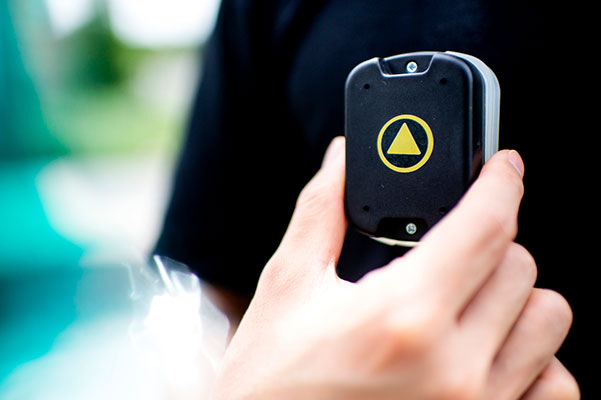
Featuring Jignesh Jadhav, ME’20, data analytics engineering, and Yiqiang Wang, ME’20, computer systems engineering
At their co-op at Iterate Labs, data analytics engineering student Jignesh Jadhav, ME’20, and computer systems engineering student Yiqiang Wang, ME’20, helped develop wearable devices to keep employees physically distanced and to assist with contact tracing. Jadhav’s experience as a contact tracer inspired him to figure out a more effective way to track infections. Wang brought the idea to life by building the back-end software. The pager-like beacons alert wearers when they are too close to others. Employees put the beacons on when they arrive at work, and the devices use short-range radio technology, called ultra-wideband, to communicate and record when two devices come in close contact, uploading that data to the cloud. Then, if someone’s been diagnosed with COVID-19, the system can map whom that person has been in contact with. Jadhav and Wang wanted to make the beacons easy to use so that companies can get the process up and running quickly. A company just has to set up location-tracking hubs throughout the facility—similar to a Wi-Fi router—and connect the beacons to the hub, a process that takes around 15 minutes.
Anna LeClair, E’23, environmental engineering, was awarded a PEAK Experience Award from Northeastern University’s Office of Undergraduate Research and Fellowships. Advised by Assistant Professor Kelsey Pieper, LeClair’s research project is, “Safely Reopening Buildings After the COVID-19 Shutdown: Investigating Lead Leaching and Corrosion Scales in Drinking Water.” The COVID-19 pandemic forced commercial and academic buildings to abruptly close, causing drinking water systems to stagnate. Corrosion scales that form protective layers inside pipes become destabilized during stagnation, causing lead and other metal leaching and rendering drinking water unsafe. LeClair’s bench-scale experiment will investigate this poorly understood phenomenon and determine safe reopening procedures after 1-4 weeks of stagnation to prevent harmful lead exposure. She will present the findings at Northeastern’s RISE research expo and other conferences. The findings will be used to revise current EPA utility reopening guidelines.
William Olson-Sidford, E’22, bioengineering, who works on SARS-CoV-2 research, co-authored a paper with Professor and Chair Lee Makowski, bioengineering, on a hypothesis that was recently published in the journal Viruses. The paper theorizes that the spike protein found on the surface of the COVID-19 virus may bind to cellular receptors that regulate blood vessels and control the formation of blood clots, which could explain many of the non-respiratory complications of COVID-19. The spike protein is an arm-like apparatus that the virus uses to attach to and enter healthy cells. At the tip of the spike protein rests a string of three amino acids called RGD. RGD can contribute to the formation of blood clots and the growth of new blood vessels when it interacts with cell receptors called integrins. “Other proteins that have RGD are known to cause complications. Our theory is that RGD is making it easier for the virus to bind to things that could cause these blood complications,” says Olson-Sidford. Recognizing that coagulation is a major problem has greatly improved the survival rate of people who are severely sick with COVID-19, Makowski says. Uncovering the cause of that coagulation is the next step.
